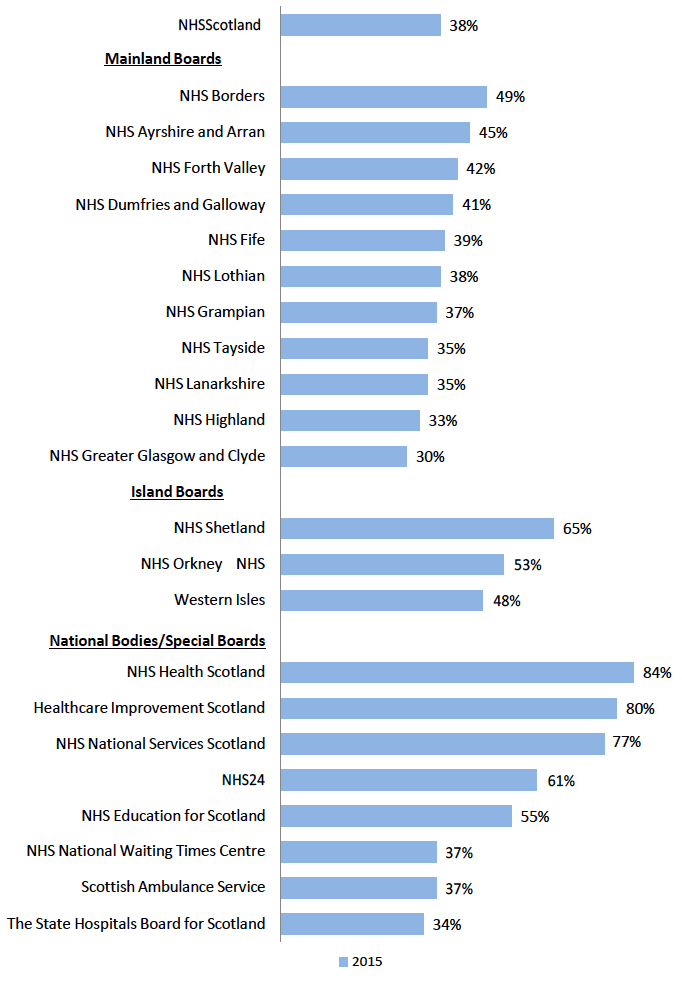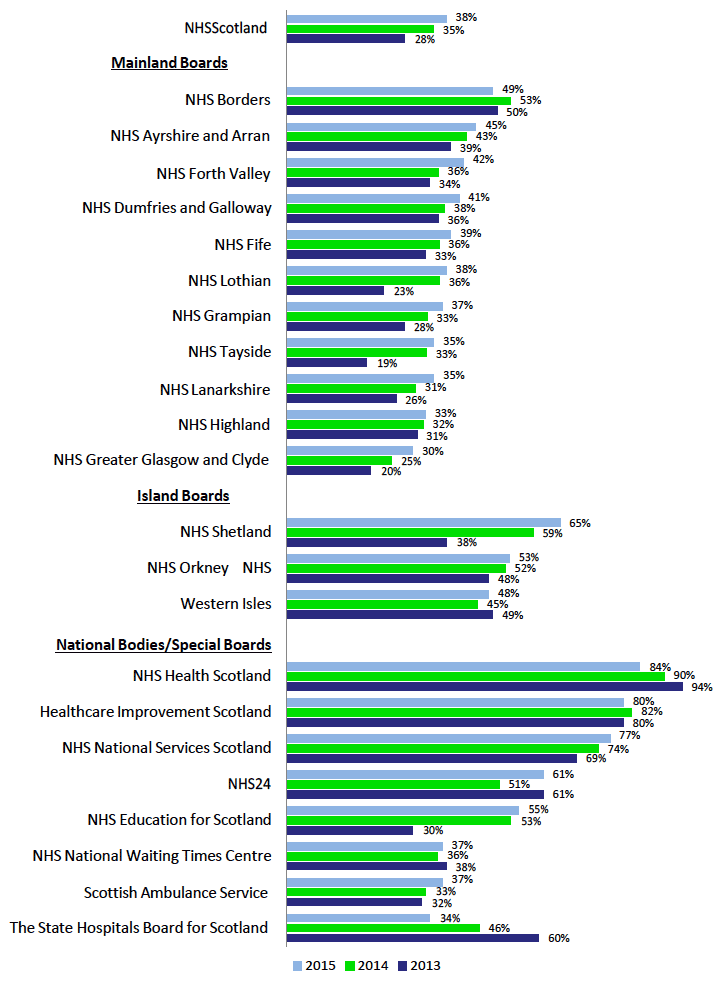NHSScotland Staff Survey 2015 National Report
This National Report provides an overview of the results of the 2015 NHSScotland Staff Survey. The National Staff Survey gives all NHSScotland staff the opportunity to provide feedback on their experience of working for the organisation.
4 Response rates
During the survey live period, 60,681 NHSScotland staff completed a questionnaire and submitted their views to Capita Surveys and Research, which calculates as a 38% response rate based on 160,635[2] employees and is the highest participation rate of the survey since its inception. In 2015, there was an increase in participation of three percentage points on the 2014 staff survey (an additional 5,604 staff on 2014 survey). The majority of staff (92%) submitted their response via the on‐line survey; around 8% were submitted by post using a paper questionnaire (this was 12% in 2014), with less than 1% using the telephone completion service.
Response rates varied between Health Boards, from 30% to 84%. NHS Health Scotland had the highest response rate (84%), followed by NHS Healthcare Improvement Scotland (80%). NHS Greater Glasgow and Clyde had the lowest response rate (30%).
Eighteen of the 22 Health Boards improved their response rates (by between 1 and 10 percentage points) on the 2014 survey. The largest increases in response rates were recorded by NHS24 (+10 percentage points), NHS Shetland and NHS Forth Valley (+6), NHS Greater Glasgow and Clyde (+5) and NHS Lanarkshire, Scottish Ambulance Service and NHS Grampian (+4). Of the four Health Boards with response rates lower than in 2014, The State Hospitals Board for Scotland recorded the largest fall in response rate, from 46% to 34%.
Health Boards were grouped into three types for analysis: Mainland Boards; Island Boards and National Bodies/Special Boards.
The National Bodies/Special Boards had the highest average response rate (58%), and the Island Health Boards had an average response rate of 55% and Mainland Health Boards had an average response rate of 39%. The higher response rate for staff working in some National Bodies/Special Boards may reflect the fact that the majority of these staff are office‐based administrative and clerical staff with direct access to a computer. For individual Health Boards, the lowest response rates tended to be in the larger Mainland Boards, whilst the smaller Island Boards had higher response rates.
Three Boards operated their survey entirely online (with the option to complete via a telephone interview), the remaining 19 provided paper questionnaires to a proportion of their staff for whom computer access was limited. Across these Boards, the proportion of responses submitted on paper ranged from 0% to 31%.
As noted above, the sample profile for the 2015 survey is described at the end of this report in Figure 13 Participant Profile. Figures 13 and 13a shows the employment profile and Figures 13b to 13e provide the socio‐demographic profile.
The overall staff group participation profile has shown little change between 2014 and 2015 survey results, which provides a good basis for a consistent comparison between the years.
Figure 1a shows response rates for Health Boards for 2015.
Figure 1b shows a comparison of response rates between Health Boards for 2015, 2014 and 2013.
Figure 1a: Percentage of staff who completed the NHSScotland Staff Survey 2015, by NHS Board (grouped by Board type and ranking of response rate)[3 4]

Figure 1b: A three year comparison of the 2013, 2014 and 2015 response rates for the NHSScotland Staff survey by NHS Board (grouped by Board type and ranking of response rate)[5 6]

Contact
Email: Malcolm Summers
There is a problem
Thanks for your feedback